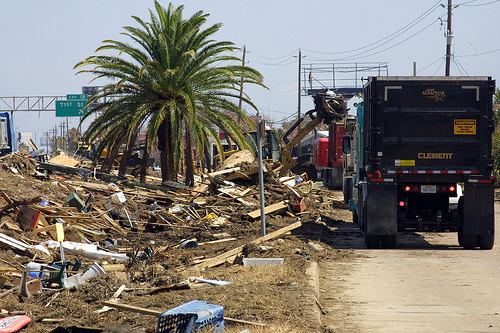Katrina: Five years later…and building strong!

The Inner Harbor Navigation Canal surge barrier floodwall the Corps’ largest-ever design-build civil works project. At almost two miles long, this $1.3 billion project is being called the “Great Wall of Louisiana.”
Five years ago, communities along the Gulf Coast experienced devastating loss and damage as a result of Hurricanes Katrina and Rita. As the long road to recovery began for thousands of Americans impacted by this tragedy, the Corps was called upon to do their part to help rebuild, restore and reconstruct the Hurricane and Storm Risk Reduction System in the Greater New Orleans area.
What was once a patchwork of levees, floodwalls and pumps before the hurricanes is becoming a true System that will provide 100-year level perimeter protection against hurricane storm surge to greater New Orleans. Today, the area already has the best perimeter defense in its history, and work continues at a record pace. We are driving hard to have in place a system that can defend against a 100-year storm by June 2011.
We are working towards this goal by using the best science, technology and talent available, leveraging the knowledge and capability of our partners in industry, architect-engineer firms, members of academia and international counterparts. Together, we are developing and applying state-of-the-practice engineering solutions to the Hurricane and Storm Risk Reduction System and across coastal Louisiana.
With this scientific expertise, we were able to design and have nearly completed construction on the Inner Harbor Navigation Canal Surge Barrier, the Corps’ largest-ever design-build civil works project. At almost two miles long, this $1.3 billion project is being called the “Great Wall of Louisiana,” and it is one of the key components in the Hurricane and Storm Risk Reduction System’s ability to defend against the effects of a 100-year storm. Another key component of the system is the nearly $1 billion West Closure Complex, a gated surge barrier containing the largest drainage pump station in the world – now at 40% complete after only one year of construction.
Other major work accomplished since Katrina includes:
• completion of all pump station repairs
• completion of one-third of pump station storm proofing projects
• raising the height of more than 15 miles of levees and 2.5 miles of floodwalls throughout the West Bank
An unprecedented number of construction contracts has been awarded for this mission (more than 270), and more than $9 billion obligated. What’s even more exciting is that about $2.3 billion has been awarded directly to Small and Disadvantaged Businesses, and more than 60% of these awards have gone to Louisiana-based businesses.
We are committed to providing a system that will defend against the effects of a 100-year storm by June 2011. But we aren’t done. Work will continue beyond 2011 to complete other features of the system. We will continue to use all available resources and Corps expertise across the Nation to deliver this essential system to the citizens of Greater New Orleans and Southeast Louisiana, and together with our state, local and federal partners, we will get ‘er done!
Best,
Van
BUILDING STRONG®

